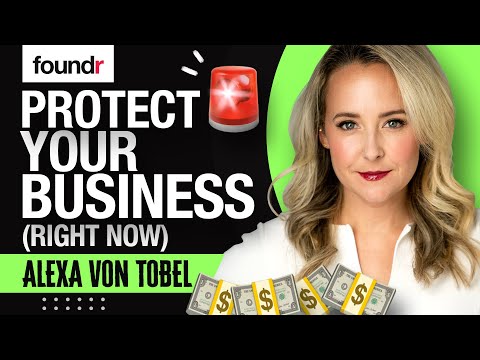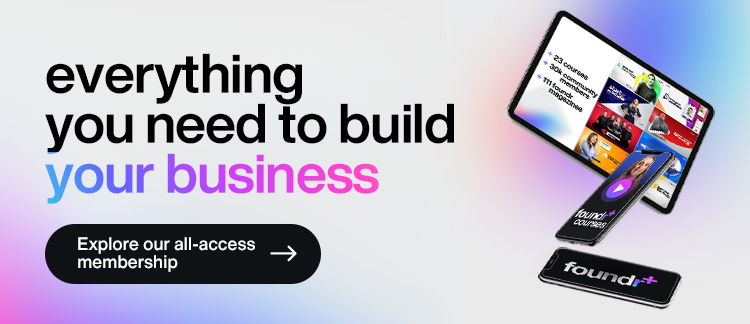Want to start a business but not sure how? You’ve come to the right place. We’ll walk you through each of the necessary steps to starting a new business and provide links to more robust resources for each step whenever necessary. Because starting a business is scary enough, you don’t need the anxiety of wondering if you’re doing the right thing or trying to follow nebulous instructions.
Table of Contents
2. Identify Your Target Market
5. Determine Necessary Funding (and Secure It)
6. Select Your Business Location
7. Choose Your Business Structure
11. Acquire Necessary Licensing and Permits
12. Open a Business Bank Account
13. Build Your Team and Tech Stack
16. Continue to Adapt Until You Find What Works
“Starting a Business” Checklist and FAQs
Let’s not waste any time.
1. Perform Market Research
Market research is the process of gathering information about your proposed market, potential audience, and customer base. Market research lays the foundation for any successful business, providing you with as much information and insight as possible when starting your new business.
For in-depth instructions on how to conduct market research, check out “The Complete Guide to Market Research: What It Is, Why You Need It, and How to Do It.”
The Goals of Market Research
- Understand current market conditions and identify your opportunities and challenges. What problem needs solving? What process or industry can be proved upon?
- Identify your target market and create foundational marketing materials, like buyer personas, to inform your marketing and customer acquisition efforts.
- Validate your initial concept.
Why You Should Do Market Research When Starting a Business
Market research should be one of the first steps to starting a business. It provides you with valuable information that will help you generate revenue quickly and avoid costly mistakes.
Types of Market Research
Primary research is much more fruitful for a new business than secondary research. Therefore, every entrepreneur should spend the time and energy performing their primary research to get a sense of what matters to a potential customer.
On the other hand, secondary data is much easier to track down (you can probably find a few valuable resources with a simple Google search). Because of this, many entrepreneurs choose to start here. Once you’ve gained a general overview of market conditions from your secondary research, you can pursue your primary research with a more nuanced perspective.
The types of market research:
- Primary research
- Interviews
- Market surveys
- Competitive analysis
- Social media analysis
- SEO research
- Secondary research
- Market studies
- White papers
- Public data
2. Identify Your Target Market
Your target market is the specific group of customers that would be interested in your business’s products or services. It’s a subgroup within the total market for a product or service type. Defining your target market is essential for developing a successful marketing strategy.
For step-by-step instructions, consult “The Guide to Defining Your Target Market.”
Steps to identifying your target market:
- Analyze the total market conditions
- Look at what your competitors are doing (and not doing)
- Use the findings from your market research
- Pull information from social media
3. Write a Business Plan
Creating a business will help your new business secure financing—whether from investors or a business loan—and stay focused on initiatives that will serve your strategy. Ultimately, a business plan works as a road map that will help your business succeed. For example, one study of more than 1,000 aspiring entrepreneurs found that those who had created a business plan were 16% more likely to achieve viability than those who didn’t.
Your business plan will outline:
- What your business does
- Who it serves
- How it makes money
- Its plans for growth
The Elements of a Business Plan
Business plans generally follow this format:
- Executive summary
- Business description
- Market analysis
- Products and services
- Marketing
- Financials
You can find full details and a business plan template to help you complete each section in our guide, “How to Create a Business Plan (Step-by-Step Walk-Through With Examples).”
4. Test Your Concept
You can use the information you’ve cultivated in the first 3 steps to validate your business idea. One of the most nimble ways to approach this is to launch your business as a side hustle. Starting your new business as a side hustle will let you test the market, adjust your product offerings, and build an email list/social media following before taking the financial risk of becoming a full-time small business owner.
When restaurants open, they start with a soft opening. It gives the business time to work out the kinks—the kind you can only see once you’re up and running—before the grand opening. It also helps build buzz. Think of your side hustle the same way. It lets you validate and test your business so that when it’s time to launch, you cross the start line from a full sprint.
5. Determine Necessary Funding (and Secure It)
Every new business has startup costs. The amount of capital you’ll need varies depending on your industry, but your business plan should give you a solid sense of how much money you’ll need. If you haven’t already, do industry-specific research to determine your startup costs and how you’ll pay for your new business.
What You May Need Funding For
Typical startup costs include:
- Equipment
- Incorporation
- Licenses and registration fees
- Insurance
- Website
- Employees (payroll)
- Inventory
- Office space
- Retail space
- Utilities
- Business taxes
Ways to Finance Your Small Business
Securing financing for a business can take time, especially if you’re applying for a bank loan or SBA loan, so begin securing your funding now to ensure you maintain the cash flow you need for your new business.
The most common forms of small business funding include:
- Bootstrapping or self-funding: You can pay for your business yourself, which allows you the most autonomy. It helps you keep full ownership for yourself (or split with a business partner if you have one). The drawback of bootstrapping? Some new businesses cost more to launch than an entrepreneur has in savings.
- Friends and family: Many entrepreneurs turn to friends and family to help them close the gap and cover their startup expenses. The benefit of friends and family funding is that it can be quicker and easier to get than a loan or venture capital. The drawback is that it can get messy, especially if you don’t have a clear contract outlining what friends and family will get in exchange for their investment. (Pro tip: Always, always put this in writing. It doesn’t matter how close you are. It will get messy later if you don’t.)
- Small business loan: You can secure funding for a small business by applying for an SBA loan, a traditional small business loan, or through online lenders. This option allows you to maintain full ownership of your business, but it can come with a high cost of capital. For loans with an affordable cost of capital (like SBA loans), the process takes time and can be competitive.
- Grants: Grants provide the opportunity for “free money.” The downside is that they are competitive, and the applications can require a lot of time and energy.
- Venture capital: Depending on what type of business you’re starting and how scalable it is, you might be able to secure venture capital. The operative word there is might. Venture capital is highly competitive, and if you do secure funding this way, you will have to give up equity in your company. Plus, you’ll have a lot of pressure on your business performance from the very start.
6. Select Your Business Location
Where will your business be? Do you need a physical space, or will your team be remote? Ask yourself these questions. If you’re starting a brick-and-mortar retail business, you’ll want to scout the location for your first shop. If you’re going to need office space, now is the time to find it.
Due to the increase in remote work, more and more coworking and incubator spaces are opening. Look for a space that you can grow into and has a supportive and collaborative community. There’s nothing better than a built-in network to help grow your small business.
7. Choose Your Business Structure
Before starting your business, you want to determine what legal structure you want your new business entity to have. Here are your options:
- Sole proprietorship: A sole proprietor is someone who owns an unincorporated business on their own. This business model is best if you know you will remain a solo operation or keep your business as a side hustle.
- Limited Liability Company (LLC): An LLC is a hybrid model that allows you to form your business as a corporation or a limited liability partnership. With an LLC, business owners are protected from business liabilities similar to how they would be with a corporation.
- Corporation: Corporations are the most complicated business structure, but they also provide better tax rates (and protect business owners from liability). S-corps and C-corps are the most common corporation types for small businesses.
- Partnership: A general partnership is an arrangement where 2 or more individuals agree to share a business’s assets, profits, financial obligations, and legal liabilities.
8. Name Your Business
It’s time to name your business. A good name should be easy to remember, generate interest, and allow for flexibility as your business grows and changes. You don’t want your business name to be too literal, box you in, or tell the whole story (it can’t).
The 4 Types of Brand Names to Choose From
There are 4 general business naming conventions:
- The general brand name
- The descriptive brand name
- The suggestive/associate brand name
- The coined, random, or abstract brand name
Want more help? Check out Coming up with a Business Name That Shines.
9. Register Your Business
Your business structure and location will dictate whether you need to register your business. For many companies, you’ll just need to register your business name with state and local governments.
For others, you may need a federal license or to register with certain federal agencies. You can consult the SBA for more details.
10. Get Your Tax IDs
You need to register with federal and state governments so that you can appropriately track and pay employment tax and business taxes.
You’ll need:
- A federal Employer Identification Number (EIN)
A state Tax ID number
11. Acquire Necessary Licensing and Permits
Depending on your business type or industry, you may need to secure business licenses or permits. Secure any necessary federal, state, or municipal licenses before you begin operating your small business.
12. Open a Business Bank Account
Opening a business bank account will help you manage your cash flow and keep track of your business expenses and revenue. You want to keep your personal and business finances separate to prevent mistakes and to ease tax preparation.
13. Build Your Team and Tech Stack
Your small business team might just be a party of one for now, but you’ll need tools to lead you to success. Here’s a basic tech stack checklist to start a small business.
- Office tools (G-Suite, Microsoft Office)
- Sales or accounting software (QuickBooks, Minted)
- Website hosting service and platform (Squarespace, Wix, WordPress)
- Email marketing software (Mailchimp)
- Video conference software (Zoom)
If you’re building an agency, ecommerce, or Saas small business, you’ll likely need to expand your tech stack as you grow.
Your team might include a cofounder or partner, but it also could be a team of freelancers. Here are team members (or freelancers) you should think about adding to your small business sooner rather than later.
- Social media marketing
- Website development
- Graphic design
- Advertising
- Copywriting
The key to starting your small business is to invest in what provides value for your future customers. Don’t spend your dollars on enterprise-level software or team of 10 freelancers until you’ve completed the steps on this list and proven your model.
Read more: Find a Business Partner Who’ll Help (Not Hurt) Your Business
14. Launch Your Business
Finally, the words you opened this guide hoping to read. You’ve taken all the necessary steps to start your business. It’s time to launch. Open your doors (metaphorically, if you’re launching an online business). Here are some basic launch steps to prepare you for success from the start:
- Claim your social platforms (even if they’re personal)
- Make sure your website is live and up to snuff (at minimum, make sure your customers can contact you)
- Reach out to your network announcing your launch date
- Build hype on social media before launching
- Have a digital (or physical) launch event
It’s time to welcome your customers and start generating revenue.
15. Market Your Business
Marketing spreads the word about your small business. The way you approach marketing depends on your industry, audience, and budget. Here are the top marketing channels you should consider, according to “Small Business Marketing: The Ultimate Guide for Entrepreneurs.”
Marketing Assets Every Small Business Should Have
- Website
- Social media profiles
- Google Business profile
- Phone number
5 Strategic Ways to Market a New Business
- Email marketing
- Social media marketing
- Content marketing
- SMS (text) marketing
- Out-of-home (OOH) advertising
16. Continue to Adapt Until You Find What Works
You won’t have all the answers when you start your business. You’ll make mistakes, and some of them will cost money. That’s all OK. Every entrepreneur makes mistakes. Viable businesses set themselves apart by adapting. Stay agile and flexible so that you’re ready to adjust once you see what works and what doesn’t.
The Complete “Starting a Business” Checklist
- Conduct market research
- Primary research (interviews, surveys, competitive analysis, social media/SEO research)
- Secondary research (market studies, white papers, public data)
- Identify your target market
- Create a business plan
- Executive summary
- Business description
- Market analysis
- Products and services
- Marketing
- Financial
- Test your concept
- Determine and secure funding
- Choose your business location (if necessary)
- Select a business structure
- Name your business
- Register/incorporate your business
- Obtain Tax IDs
- Federal Tax IDs
- State Tax IDs
- Obtain necessary licensing and permits
- Open a business bank account
- Get your tech stack
- Build your team
- Launch
Small Business FAQs
Q: What’s the best type of small business to start?
The business that aligns with your why. Whether you’re a developer or dog walker, starting a small business is hard. Without passion for what you do, your business is doomed to fail. Still, stuck? Here’s a list of business ideas to get started.
Q: When is a good time to start a business?
If not yesterday, today. Many small businesses start as a side hustle. Read this article to learn when to know to quit your job and go all-in on your business.
Q: Should I have a personal or business brand?
Both. You can’t separate your business from your identity. Networking tools like LinkedIn make it crucial to build your personal brand alongside your business. Read this article to learn how to build a personal brand that skyrockets your business.
Q: Should I hire a marketing agency?
There’s a wide variety of marketing agencies out there, some good, some bad. Before your sign an expensive contract, make sure you identify where you need help. We suggest that you know the basics of Facebook Ads, social media marketing, and copywriting so you can be prepared to ask the right questions to know if an agency will get results or just schedule strategy meetings.
Q: How do I know my product is good?
Good is a relative term. A better question to ask is whether your product solves a problem or fits a market? Read this article to find your product market fit.
Ready to Build Your Business?
No matter where you are on your entrepreneurial journey, we’re here to help. With unlimited access to world-renowned instructors, proven frameworks, and like-minded communities, foundr+ has the ever-expanding courses and experiences to help you build your dream business.
The post 15 Steps to Starting a Successful Small Business appeared first on Foundr.






